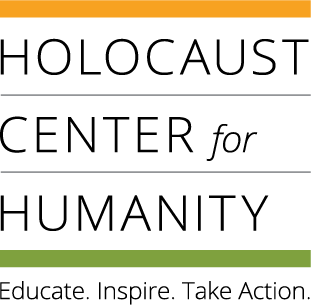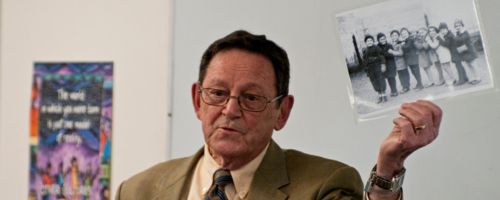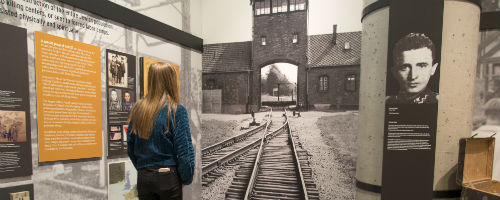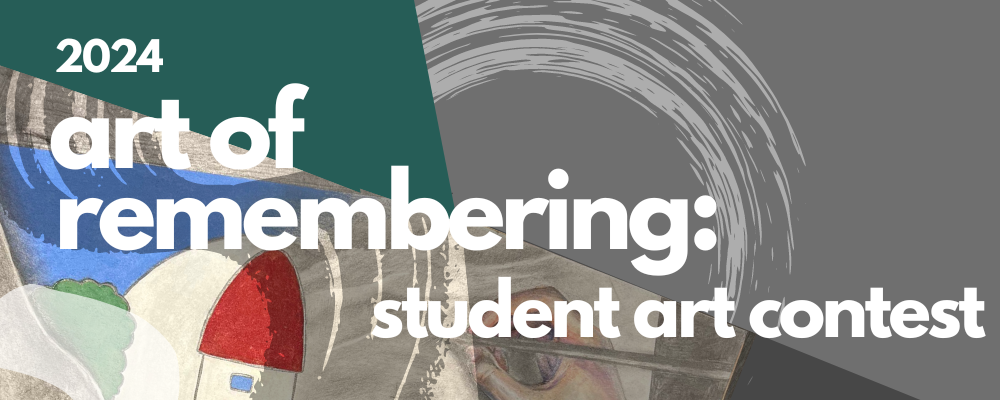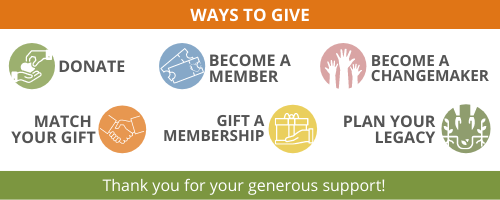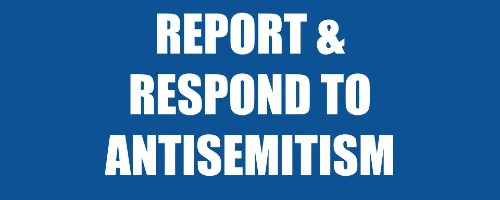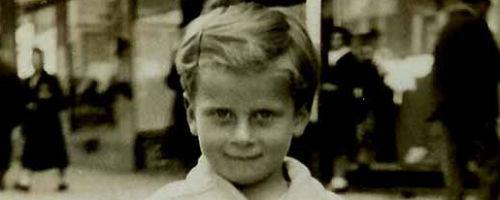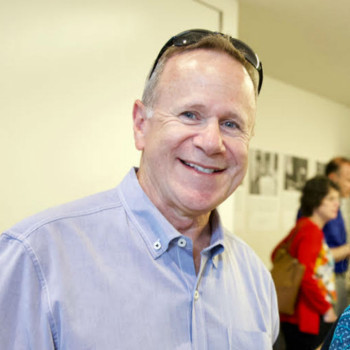
 Jack Schaloum is the son of Holocaust survivor Magda Schaloum, a Hungarian survivor of Auschwitz and other concentration camps.
Jack Schaloum is the son of Holocaust survivor Magda Schaloum, a Hungarian survivor of Auschwitz and other concentration camps.
Magda was born to a loving family in 1922 in Gyor, Hungary. Following the German occupation of Hungary on March 19, 1944, the Nazis began systematicall y depriving Jews of their rights and forcing them into ghettos. They forced Magda and her family to leave their home and deported Magda, her brother and mother to Auschwitz.
Through the window of the cattle car, Magda saw her father desperately trying to give them a package filled with food and essentials. The SS guards treated him brutally, but took the package and told him they would give it to his family. Instead, the SS guards kept it for themselves. Magda’s father was held for forced labor in the coal mines, and the Nazis eventually transported him to the Buchenwald slave labor camp in Germany. Magda’s sister avoided deportation thanks to one of the protective papers from the Swedish diplomat Raoul Wallenberg, later declared a Righteous Among the Nations.
After riding for days in the fetid cattle car, Magda arrived in Auschwitz, only to be separated from her brother, 15, and her mother, 56. The Nazis forced Magda to processing where they tattooed a number on her arm.
At Mühldorf, (another slave labor camp) in April, 1945, Magda met the man she would eventually marry: Mr. Izak Schaloum, a Sephardic native of Salonika, Greece. Their stay at Mühldorf was brief. The Nazis loaded them onto a cattle wagon with other survivors to be transported to an unknown spot to be murdered, but Allied troops liberated them along the way.
Magda passed away in June 2015. Her son Jack is a member of the Holocaust Center for Humanity's Speakers Bureau and is carrying on his mother’s legacy by sharing her story.
To learn about Magda's story, visit the Survivor Encyclopedia.
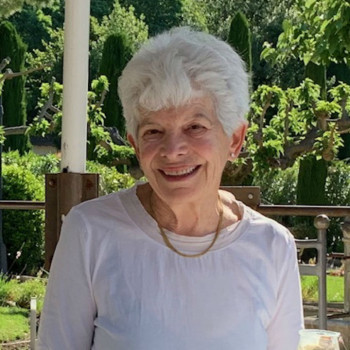
 Judy Schocken’s story is about how the Nazi rise to power affected her family in Czechoslovakia, changing their future forever.
Judy Schocken’s story is about how the Nazi rise to power affected her family in Czechoslovakia, changing their future forever.
Judy’s paternal grandfather lived in Czechoslovakia, where he had a business selling wholesale eggs. As antisemitism grew during the early 1900s, he moved his family several times within Czechoslovakia for their safety. With Hitler as chancellor of Germany since 1933, the borderlands of Germany and Czechoslovakia increasingly became a target for the Nazis’ territorial ambition. Judy’s father Frantisek “Frank” studied refrigeration in the United States in 1936, so the family could improve their egg business, but he returned to Czechoslovakia.
After several difficult moves in search of a better life, the family decided to send Frank, his wife Margaret, and their infant son, Peter, to the United States. The plan was to eventually have them send for the rest of the family. The Blochs were fortunate to have a relative in Seattle who served as a sponsor; the three obtained visas in 1938 and arrived in Seattle in January 1939, less than a year before World War II broke out.
The Bloch family changed their surname to “Block” and settled into life in Seattle. Judy and her older brother Steve were both born in the United States. Frank eventually returned to the egg business, and the whole Block clan spent lots of time with other Jewish refugee families from the same part of Czechoslovakia, particularly enjoying hiking and skiing together.
Unfortunately, no other immediate family members of Judy’s parents were able to leave Europe. Judy and her father both spent time researching their relatives’ fates – information that Judy describes in her presentation. She collected additional primary sources and family photos, and, with the help of the Holocaust Center for Humanity, put the pieces together.
As the daughter of those lucky enough to escape the Holocaust, Judy shares her story as a member of the Center ’s Speakers Bureau to tell about the effects of bigotry, bullying, and antisemitism. Judy and her husband Joe still live in the Seattle area, and have 4 children and many grandchildren.
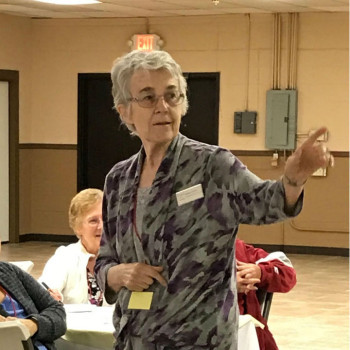
Daughter of Dutch rescuers, Ingrid shares the story of her family's bravery to hid 40 Jewish people during the Holocaust.
 Ingrid Kanis Steppic was born in Holland in 1943. Her father, mother and older sisters hid 40 Jews in Holland during the Holocaust. She is now telling her story of this family of rescuers.
Ingrid Kanis Steppic was born in Holland in 1943. Her father, mother and older sisters hid 40 Jews in Holland during the Holocaust. She is now telling her story of this family of rescuers.
Ingrid’s family moved to Amersfoort only one day before the Germans invaded Holland on May 10th, 1940. Her father, Jan, was to be the manager of the town post office. His position allowed him to see returned mail and death notices. He realized that the Nazis were killing Jews long before many others found out, and he encouraged many Jews to go into hiding rather than register.
Jan helped Jews hide in Amersfoort or nearby Oldebroek, where he had grown up. The ‘hiders’ would first come to Ingrid’s house, and then her father would find a place for them. Her mother, Nel, was unfailingly vigilant to keep the Germans from discovering them. Her older siblings helped. Jan and Nel kept in touch with the people they had hidden.
Jan was also involved in the Dutch Underground. On one occasion, a raid had been planned on a distribution center to acquire the stamps for ration cards. Jan was forced to flee the scene and go underground. He was arrested and sent to Dachau in 1944.
Shortly after, Ingrid’s older sister Ali, was found with incriminating receipts from striking railroad workers, and was also arrested. Ali spent the rest of the war in a women’s prison, forced to mend clothing for German soldiers.
Without the pay from Jan’s job, or Ali’s help at home, Nel was hard-pressed to make ends meet during the infamous “Hunger Winter” of 1944-45, especially with a young child. The Kanis family continued to live in Amersfoort after the war was over. Ingrid married an American soldier and moved to the United States. In 1971, Ingrid’s parents were honored by Yad Vashem in Israel as "Righteous Among the Nations."
Between 20,000 and 30,000 Jews were hidden in Holland during the war. This included the Frank family. Of this number, about 2/3 survived.
Ingrid is a member of the Holocaust Center for Humanity’s Speakers Bureau, and presents her family’s story to local students and community groups.
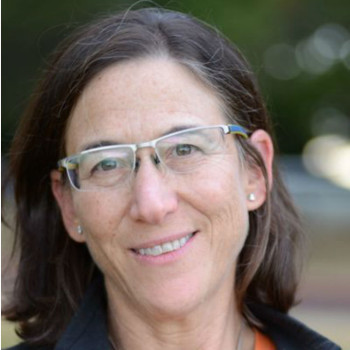
 Karen Treiger shares the survival story of her mother- and father-in-law, Esther and Sam Goldberg. Karen knew that they had amazing stories of survival, but she wanted to fully understand their struggles and experiences and began to research their stories.
Karen Treiger shares the survival story of her mother- and father-in-law, Esther and Sam Goldberg. Karen knew that they had amazing stories of survival, but she wanted to fully understand their struggles and experiences and began to research their stories.
Esther and Sam both grew up in Poland prior to the outbreak of World War II. Sam was drafted into the Soviet Army and imprisoned in a German POW Camp. He escaped, but was eventually deported to the Nazi death camp Treblinka. In 1943, Sam escaped from Treblinka and found safety in a nearby forest, where he met Esther. Esther had already established a hiding place there after fleeing Stozeck, Poland.
Esther and Sam survived in hiding with the help of the non-Jewish Stys families. After the birth of their first child and several years in displaced persons camps, the Goldbergs came to the United States in 1949.
In 2016, Karen and her family traveled to Poland to meet the children of the Stys families, and thank them for their courage in saving the Goldbergs’ lives. This incredible connection has continued to inspire Karen to tell her family’s story, and now to share it with students and other groups as a Legacy Speaker for the Holocaust Center’s Speakers Bureau.
Karen Treiger's award-winning book, My Soul is Filled with Joy: A Holocaust Story, details the story of the Goldbergs and her own journey in uncovering this history. She is a lawyer and has four adult children with her husband – Sam and Esther’s son – and resides in Seattle.
